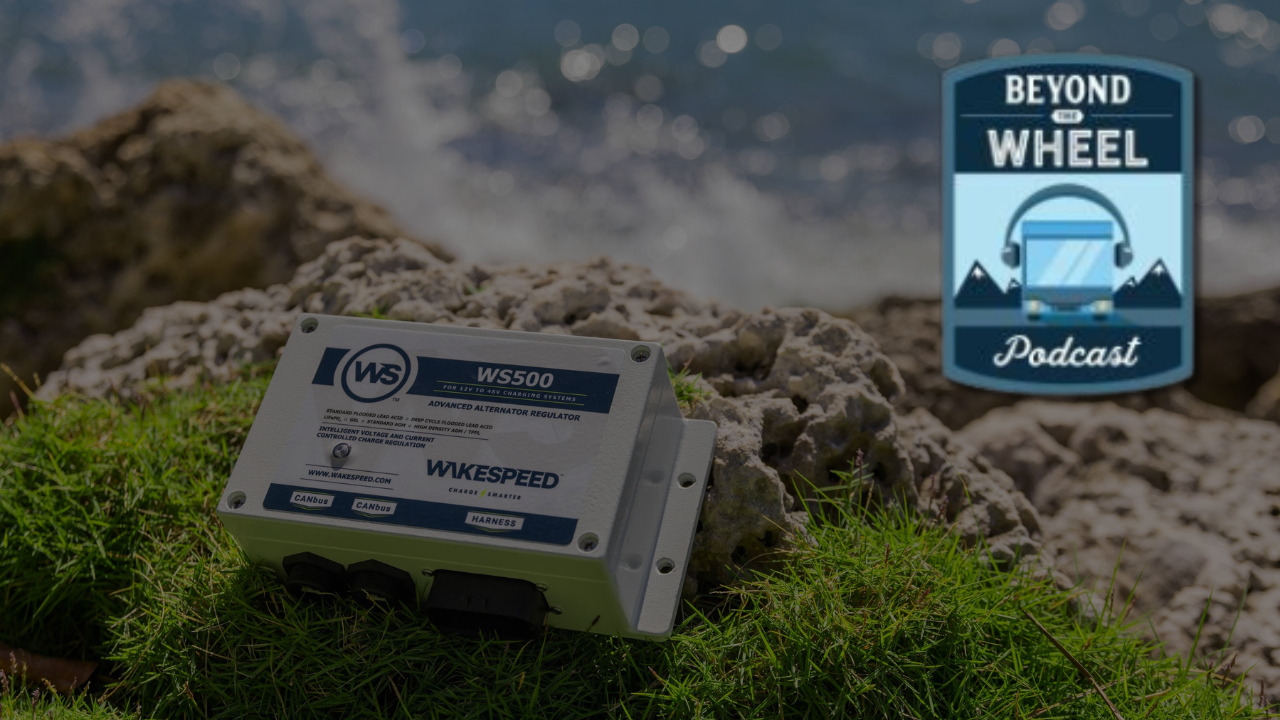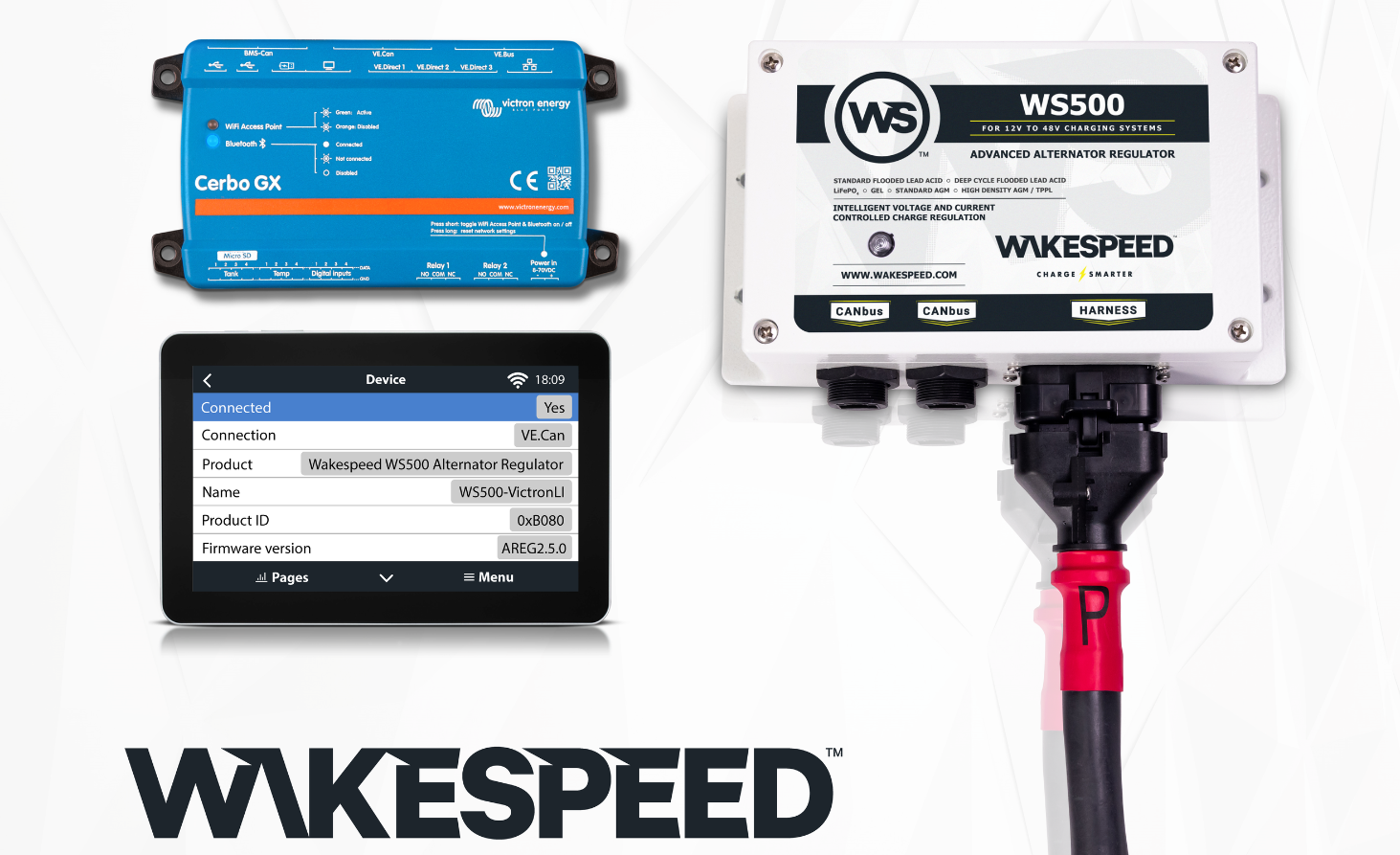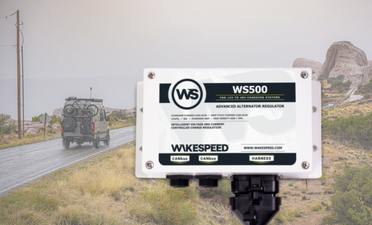
Videos
Wakespeed 101 | Advanced Alternator Regulator Training Seminar
Al Thomason leads a comprehensive training seminar at the Northwest School of Wooden BoatBuilding
Wakespeed 201 | Advanced Alternator Regulator Training Seminar
An extensive training seminar of the WS500, including CAN capabilities, at the Northwest School of Wooden BoatBuilding
Alternator Supercharging Using the WS500 Pro & 48V/12V Bi-Directional DC-DC Converter
Safe, intelligent, and advanced 48v power system supercharging
WS500 at the Overland Expo 2022 | Outdoor X4 Magazine
Chad of Living the Van Life speaks with OutdoorX4 about the WS500 Advanced Alternator Regulator
Wakespeed Configuration Utility App
Overview
Wakespeed Configuration Utility App
Basic Configuration
Wakespeed Configuration Utility App
Transfer a Configuration File
Wakespeed Configuration Utility App
Fault Codes
Wakespeed Configuration Utility App
Expert Mode
Wakespeed Configuration Utility App
Monitoring
Wakespeed Configuration Utility App
Logging
Wakespeed Configuration Utility App
Device Firmware Updates
Introduction to the Wakespeed WS500 Pro Bluetooth® Advanced Alternator Regulator
The new Wakespeed WS500 Pro Bluetooth® Alternator Regulator integrates with the Wakespeed Configuration and Monitoring Utility App.
The Wakespeed WS500 vs. WS500 Pro with Bluetooth® Advanced Alternator Regulators
The WS500 Pro is the latest iteration of Wakespeed’s advanced DC charge regulator, building on the proven foundation of the WS500.
Connecting the Wakespeed WS500 Pro Alternator Regulator via Bluetooth®
Using the Wakespeed Configuration and Monitoring Utility App, power on the WS500 Pro, and ‘Scan for Bluetooth Regulator’ to find your device.
Connecting the WS500 Pro Bluetooth® Alternator Regulator via Android-OTG
Users can connect a WS500 Pro Bluetooth® Alternator Regulator directly using an Android OTG cable.
Connecting Passwords & Read-Only Mode for the WS500 Pro
Read-only mode is a unique and beneficial feature that allows service technicians or OEMs to access the regulator’s data without making changes.
Read-Only Mode for the WS500 Pro | Verification Without a Password
Wakespeed’s read-only mode is designed for situations where you either don’t know the password or need to access a regulator without making changes.
Plug-n-Go Alternator Charging With the Wakespeed WS500 Pro
The W500 Pro’s Plug-n-Go functionality simplifies the installation process, leveraging Wakespeed’s extensive experience with high-energy systems.
Integrating the WS500 Pro with Dragonfly IntelLigence™ Smart Lithium Battery
The Wakespeed WS500 Pro Bluetooth® Alternator Regulator can be integrated with Battle Born Batteries equipped with Dragonfly IntelLigence™.
Performing an OTA Firmware Update for the WS500 Pro Using Bluetooth®
Users can perform over-the-air (OTA) firmware updates on Wakespeed’s WS500 Pro Bluetooth® Alternator Regulator using wireless Bluetooth® connectivity.
Updating Firmware via Sideload for the WS500 Pro
Users can also update firmware for the WS500 Pro via sideload in Expert Mode, which is an alternative to cloud-based OTA updates.
Explaining Single Device Bluetooth® Connection for the WS500 Pro
The Wakespeed WS500 Pro Bluetooth® Alternator Regulator system supports only one Bluetooth® connection at a time.
Password Recovery on the Wakespeed Mobile App
Password recovery on the Wakespeed App is essential for cases where users forget or need to reset their passwords when using a WS500 or WS500 Pro.
Configuring 'Always On' vs. 'Engine-Only' Operation for WS500 Pro
The WS500 Pro Bluetooth® Alternator Regulator can be installed in two configurations: Always On Operation and Engine-Only Operation.
Parlay Revival Installs the Wakespeed WS500 on a Lagoon 450 Catamaran
YouTuber, Colin from Sailing Parlay Revival, installs the WS500 in preparation to cross the Pacific Ocean
WS500 Technical Deep Dive for Secondary Alternator Charging in Camper Van
Vanlife Outfitters and Valley Hi Vans do an extensive deep dive on the WS500
How-to Guides
Wakespeed Buying Guide
What you need to know when buying a Wakespeed WS500 Advanced Alternator Regulator. Is it right for your application?
Read moreWS500 & Cerbo GX Setup Guide
The WS500 is supported by Venus OS and offers performance monitoring of your alternators via a GX device.
Read moreWS500 FAQ Guide
A guide to ask the most commonly asked questions about the Wakespeed WS500 Advanced Alternator Regulator.
Read moreExtending Wires Guide
A guide to extending wires for your WS500 dependent on the location of your WS500, near the Alternator or near the battery.
Read moreFAQs
Depending on your application (RV or marine) Wakespeed has an extensive list of dealers in most areas of the U.S. and internationally. Visit our website for a directory. If there’s not an installer in your area, call our support team for recommendations.
The Wakespeed regulator is part of a fairly complex system of charging and battery components. While there is a significant amount of documentation available on our website, we recommend using a trained technician for system installation. In marine installations, we suggest finding a qualified ABYC technician, as most are well trained on systems installation and management.
Yes. The WS500 can be configured for any system voltage between 12 volts and 54 volts. In 12, 24 and 48-volt systems, the WS500 will auto-detect and set the charging voltage values for correct levels based on the system voltage.
There are many older electrical systems (and special use battery banks dedicated to loads like thrusters and trolling motors) that may require that the WS500 support unusual alternator voltage ratings; 32-volt systems, for example. The WS500 can be custom configured using the configuration utility available on the wakespeed.com technical page, or the Wakespeed Configuration App, to support system voltages other than 12, 24, or 48-volt systems.
The WS500 uses a multiplier, based on a 12-volt default standard, to determine charging voltages. In a 32-volt system, the installer would divide the system voltage by the 12-volt default to determine the multiplier needed to add to the configuration profile. That multiplier would be 2.6666666666666, or more simply, 2.67. This value would be changed in the $SCO line of the profile in the Windows utility. In the Wakespeed smartphone app, the installer would simply pick 32 volts as the system voltage.
This depends, to a great extent, on the application. In most automotive applications, like RV and commercial truck installations, the alternator is an integrated part of the engine computer control. In most cases, the internal regulator is communicating with the engine computer, and the addition of a smart regulator will not comply to emission system demands. In that case, the addition of a secondary alternator that’s dedicated to the house battery loads will be a better option. That alternator will be able to take its charging direction from the WS500. The same holds true in the marine side, where some “electronic” engines are using information from the standard alternator to control emissions and output. In that case, a second alternator may be the best solution.
With any battery that has the potential to self-disconnect from its charge source, there needs to be some level of mitigation to protect the alternator and other sensitive electronics from a disconnect/load dump event. We recommend, above all, that the alternator used is equipped with avalanche diodes. These diodes are uniquely capable of withstanding and dissipating voltage spikes created by uncontrolled disconnects. Additional protection devices designed to augment the alternator’s ability to deal with voltage spikes will add to the ability to mitigate spikes and protect the vehicle or vessel from damaging load dumps.
The capacity of the alternator is dependent on both the size and the chemistry of the batteries being charged. A rule of thumb that’s been long used with lead acid batteries is that the alternator should be capable of producing output that’s roughly 25 percent of the capacity of the batteries being charged. With LiFePO4 batteries, that ratio is a bit low. Lithium batteries, by nature, offer literally no resistance for the majority of the charge cycle, so the batteries are going to demand just about everything the alternator is capable of for extended time periods. As a result, alternator temperature becomes an issue. In most cases, lithium batteries are limited to a 0.5C-rate, so, in an ideal situation, the alternator will be rated at about half of the overall capacity of the batteries. With large battery banks, that’s not always a viable option, so one of the important features of the Wakespeed regulator is the ability to control how much output the alternator is allowed to deliver, and the regulator can also control output to maintain optimal temperature at the alternator. Both of these functions will profoundly affect the health and life span of the alternator.
The Wakespeed WS500 is well equipped to support just about any lead acid based marine or automotive battery, and can be configured using onboard DIP switches, a Windows-based computer utility, or the Wakespeed smartphone app. Due to the specialized demands of newer lithium battery chemistry batteries, there is inherently more concern about proper regulation due to the battery’s ability to self-disconnect from its charge source. As a result, Wakespeed invests a sizable amount of time in developing special configurations for LiFePO4 batteries — particularly those with internal BMS systems that don’t communicate outside of the battery. As such, the only available configurations are with battery/BMS brands where Wakespeed’s engineering team has had sufficient time to create and test safe profiles based on specific battery characteristics. As such, Wakespeed can’t guarantee results with batteries that haven’t gone through our extensive proofing protocols.
The WS500 is compatible with most analog shunts, and can be configured in the Wakespeed app to support a wide range of available shunts. Some smart shunts, however, may not be compatible. The rule of thumb is that if the shunt provides access to the two small machine screws in the side of the shunt’s maganin resistive blocks, the shunt should work. On the other hand, if there are no screws on the side of the shunt, or if they are covered up with a circuit board, the shunt will probably not work with the WS500. Wakespeed offers simple, analog shunts that are configured for a 500A/50mV capacity and resistance value.
Yes, but only if the alternator is modified to disable the internal regulator and diode trio. In many cases, this can be done quite easily by the user, but we recommend using a qualified alternator technician, if possible, to modify and test the alternator prior to installation
Due to their ability to connect regulators via CANbus, it’s possible to control multiple alternators on more than one engine to support a large battery bank. Because each WS500 remains responsible for supplying field output to its own dedicated alternator or alternators, it’s possible to combine the output from three or more alternators to support a large house bank, or even multiple house banks if the batteries are linked by CANbus enabled BMS units.
Victron’s current Venus OS 2.90 revision is compatible with the WS500 regulator equipped with Wakespeed’s 2.5.0 firmware. This combination will allow the Cerbo to display much of the WS500 regulator’s CANbus output on the Color GX display.
There are multiple options for programming the WS500 regulator, including onboard DIP switches, Windows-based configuration utilities available on the Wakespeed website, and configuration via the smartphone app, which is available through the Google Play store for Android and the Apple App Store for iPhone platforms. At present, the WS500 requires a wired connection through a USB printer-style cable, which limits actual direct configuration to the Windows and Android platforms. A wireless communication module, expected to be available in 2023, will allow direct connection and configuration via both Android and Apple iOS devices.
The WS500 is capable of providing a broad range of error and advisory codes, which are displayed by the LED that’s exposed via the jewel on the lid of the regulator. Error codes are preceded by two red “bursts” of flashes, followed by a two-digit display of flashes. In the case of an error code 44 (indicated by four flashes, a space, and four more flashes), the regulator has monitored an excessive voltage difference of greater than 2.5VDC between the regulator’s positive voltage sense (red w/yellow tracer) wire and positive power (solid red) wires. This may indicate excessive voltage drop between the two wires, or the existence of a damaged fuse in one or the other wire. A full list of error/advisory codes is available in the WS500 Communications and Programming Guide, available on our website.




